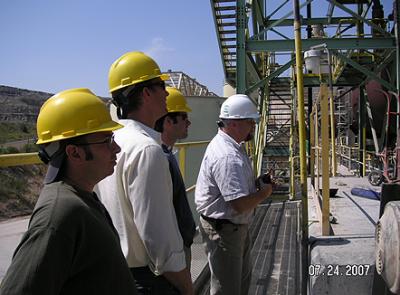Enviropreneurs
Entrepreneurs and environmentalists—they are a strange pair of bedfellows. In certain circles, it is borderline sacrilegious to utter the two words in the same breath.
Some self-proclaimed environmentalists would even argue that business and the environment mix about as well as 11 million gallons of crude oil from the Exxon Valdez mixed with the Gulf of Alaska.
After all, a successful business requires making a profit. And the idea of profiting from the environment doesn’t sit quite right in a society that tends to think you should do the right thing simply because it is the right thing, not because someone is paying you to do it.

But a nonprofit think tank in Bozeman, Montana, begs to differ. The Property and Environment Research Center (PERC) is showing environmentalists and conservationists from around the globe that business and economic principles, when applied to environmental problems, can be the most effective means to improving quality of life and the environment—at the same time.
“Doing well and doing good are not mutually exclusive,” said Terry L. Anderson, executive director and a co-founder of PERC.
For nearly 30 years, PERC has been doing research on how markets can be harnessed and used to benefit the environment; but only in the last eight years has PERC made a concentrated effort to actually put the ideas and solutions into the hands the environmental practitioners—the environmental entrepreneurs whom PERC calls “enviropreneurs.”
“It was time to take our research from the bookshelves to the environment,” Anderson said. “To come up with effective solutions, we must infuse the entrepreneurial spirit with the environment.”
At the core of this transition to the practical application of market forces to the environment was the idea that “the environment is not a problem. It is an asset,” said Bobby McCormick, a PERC Senior Fellow and professor emeritus of economics at Clemson University.
“The human mind is the world’s greatest natural resource,” McCormick said. “Unleashing that unrivaled power on what usually has been called a ‘problem’ stands to create gigantic wealth, a better environment, and an enhanced human condition.”
To this end, every summer PERC hosts 17 early- to mid-career conservationists, selected from a large pool of applicants, at its Enviropreneur Camp (ECamp) in Bozeman—a two-week program that Anderson describes as a “mini MBA” course. The program recently was awarded the international Templeton Freedom Award for Social Entrepreneurship.
The ECamp evolved in an interesting fashion. When it started eight years ago, McCormick, ECamp director, said the participants primarily were conservationists who wanted to learn more about how economics and business fit into their environmental work. The majority of last year’s class, he noted, consisted of business-oriented people who applied because they were intrigued by the idea of using their business acumen for the good of the environment.
The program begins by introducing enviropreneurs to the concepts of property rights, markets, and incentives—laying the foundation for the participants to apply critical thinking skills to environmental decision making. Later in the program, leadership skills are fine-tuned with sessions on collaboration and negotiation, project management, business planning, and communications.
ECamp culminates with each participant presenting a business plan, developed over the course of the two-week program, for a specific entrepreneurial venture addressing an environmental concern.
Charles Haine is an environmental consultant in England who has been involved with some of the world’s largest integrated oil and gas projects where development conflicted with endangered species. He applied to ECamp because he wanted a better understanding of how environmental objectives can coexist with business operations, sustainability, and progress.
“The ECamp experience was like an electric shock from a cattle prod that stimulated me to think about ways of providing practical solutions to environmental challenges,” Haine said.
Inspired by what he heard and saw at ECamp in 2003, Sam Nugent of Port Angeles, Washington, realized that he didn’t have to sacrifice financial freedom to follow his heartstrings, which were tied to a passion for the environment. Shortly after the program, he resigned from his position with a nonprofit mangrove conservation organization and joined forces with two friends to start The Remediators, a company that uses fungi to clean up chemically contaminated soils—relying on the natural ability of micro-organisms to dissolve organic compounds. The company recently won a statewide entrepreneurial award for business.
Key to the ECamp curriculum are two foundational concepts: property rights result in good stewardship of natural resources, and incentives matter. If these two notions are integrated with solutions to environmental problems, anywhere in the world, the outcome is win-win for property owners and the environment, McCormick says.
ECamp participants get to see first-hand how these two principles play out when they tour the MZ Bar Cattle Co. in Belgrade, a third-generation working cattle ranch operated by Tom and Mary Kay Milesnick. Thompson and Benhart spring creeks and the East Gallatin River meander through the ranch, making it a natural fly-fisherman’s paradise.
For years, locals just had to knock on the Milesnick’s door to ask permission to fish on the ranch. Although the Milesnicks have always been conservation minded, their priority was the revenue-producing cattle ranching, not recreational fishing. So cattle grazed pretty much anywhere and anytime in large, season-long pastures. With the herd’s unrestricted access to riparian areas, fish habitat deteriorated.
Fast forward to 1992, when the Milesnicks became more environmentally aware and decided to change grazing practices and do stream restoration work. The resulting short-duration, rotational grazing plan has earned the Milesnicks accolades from several conservation groups. After these grazing changes and stream enhancements, the fishing improved and the demand to fish became much greater. In 1999, the Milesnick Recreation Company was established along with a fee for fishing on the spring creeks, which has recouped some of the initial investment and allows for continual upgrade of the streams. The $75-per-rod fee, with a limit of six per day, generates 5 percent of the ranch revenue.
At the opposite end of the Gallatin Valley from the Milesnicks, the ECampers take an overnight trip to the Flying D Ranch, a 113,000-acre spread owned by billionaire media mogul Ted Turner. Russ Miller, general manager of Turner Enterprises Inc., discusses the ranch operations with ECampers. He prefaces his remarks with a declaration of the threefold mission of TEI’s 2 million acres of ranch holdings: to make money, to protect the environment and to promote the conservation of native species. It could be considered enviropreneurship at its best.
While surrounded by the pristine backdrop of the conservation-oriented Flying D Ranch, ECamp fellows also get to hear seasoned environmental entrepreneurs such as Hank Fischer of the National Wildlife Foundation, formerly with Defenders of Wildlife. Fischer shares his experiences with using property rights and incentives to get ranchers on board with wolf reintroduction in the Yellowstone ecosystem. Fischer spearheaded a compensation program that reimburses ranchers for livestock that is killed by wolves.
Intensely involved in endangered species restoration, Fischer recently applied the same principles to restoring grizzly habitat in the Selway-Bitterroot Wilderness that spans part of Montana and Idaho. Arranging for site-specific voluntary grazing permit buyouts that keep cattle out of grizzly-roaming areas assures that the bears can scavenge without the threat of being killed or deported for feasting on cattle.
But not all solutions are so simple—especially in developing countries, where property rights, for the most part, are non-existent. Faced with this reality, Maria Teresa Vargas and Nigel Asquith of Fundación Natura Bolivia applied to PERC’s environmental entrepreneurship program in 2005, wanting to learn how to apply innovative approaches to the escalating water rights issues in Bolivia’s Los Negros Valley, which borders Amboró National Park—one of the most biologically diverse areas in the world.
The national park and its buffer zone were increasingly threatened by illegal land incursions. Encouraged by farmers’ union leaders, migrants from the Bolivian highlands were entering the buffer zone and the park itself to extract timber and clear forest for agriculture. The local communities, with their unclear, extralegal property rights systems, often had little recourse when their lands were invaded. As a result, forests were cut, wildlife disappeared, the Los Negros River was drying up earlier every year, and agricultural production and the local economy were suffering.
Vargas led Natura’s efforts to implement a payments-for-environmental services (PES) system to combat the multiple environmental issues stemming from uncontrolled destruction of the rain forest.
The PES works like this: Downstream water users pay upstream farmers for adopting land uses that limit deforestation, soil erosion, and flooding risks. In the Los Negros Valley, this compensation took the form of one beehive and training in honey production for every 25 acres of water-producing cloud forest that upstream landowners protected. To prove that the PES system could work, Vargas’ organization agreed to fund the beehive purchases and training for the first three years. In the first year, 60 beehives were provided to five farmers. To date, 6,500 acres of rain forest has been protected in the honey-for-water scheme, and downstream water users are now paying for the upstream conservation through their local water cooperative.
More recently, Natura teamed with Steven McKean, a South African ecologist and ECamp alumnus, on a project that will look at applying a similar PES scheme to large-scale watershed conservation in South Africa and India. The joint project was awarded a $241,000 grant from the Consultative Group on International Agricultural Research.
As PERC has discovered, changing the mainstream way of thinking is a slow process and the timing has to be right for it. With issues such as climate change, species extinction, and water shortages topping the news, Anderson sees the time as ripe for implementing new, proven ideas that make business and the environment perfect bedfellows.
Robert Deacon, professor of economics at the University of California-Santa Barbara, agrees that now is the ideal time for PERC to equip conservationists with effective, innovative solutions to critical environmental concerns.
“The message [ECamp] delivers, and the tools it imparts, are exactly what resource managers and environmental policy makers need in order to make progress on these important public issues,” Deacon said.
~ Carol Ferrie is a freelance writer living in Bozeman.












Leave a Comment Here